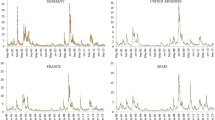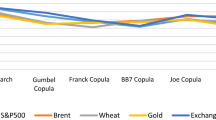Abstract
Modeling the joint distribution of spot and futures returns is crucial for establishing optimal hedging strategies. This paper proposes a new class of dynamic copula-GARCH models that exploits information from high-frequency data for hedge ratio estimation. The copula theory facilitates constructing a flexible distribution; the inclusion of realized volatility measures constructed from high-frequency data enables copula forecasts to swiftly adapt to changing markets. By using data concerning equity index returns, the estimation results show that the inclusion of realized measures of volatility and correlation greatly enhances the explanatory power in the modeling. Moreover, the out-of-sample forecasting results show that the hedged portfolios constructed from the proposed model are superior to those constructed from the prevailing models in reducing the (estimated) conditional hedged portfolio variance. Finally, the economic gains from exploiting high-frequency data for estimating the hedge ratios are examined. It is found that hedgers obtain additional benefits by including high-frequency data in their hedging decisions; more risk-averse hedgers generate greater benefits.


Similar content being viewed by others
Notes
Baillie and Myers (1991) indicated that the optimal hedge ratio is derived by minimizing the conditional variance of hedged portfolio returns.
According to Bauwens et al. (2006), the correlation models of Bollerslev (1990), Engle (2002) and Tse and Tsui (2002) belong to a model class that can be viewed as nonlinear combinations of univariate GARCH models. This key feature permits flexibility to specify the individual conditional variances and the conditional correlation separately, because the parameter vector in this model class is separable (Engle 2002).
In other words, the dependence structure symmetrically holds for both the downside and upside markets so that it does not support the hypothesis of correlation asymmetry.
Salvatierra and Patton (2015) described a new class of dynamic copula models by augmenting the generalized autoregressive score (GAS) model of Creal et al. (2013) with the inclusion of realized correlation measures, called GRAS models. It is found that the GRAS models provide superior performance in terms of density forecasting and asset allocating.
Chen (2007) indicated that this three-stage estimation method is not considered for efficiency, but it is more easily implemented when the copula model is complicated.
The sample selection rules outlined in Lai (2016) are applied. First, the records outside the time horizon when both spot and futures markets are open are deleted from the database. Second, for futures, the records of nearby contracts are used and rolled to the next month when the volume of the current month is exceeded.
The noisy overnight return is treated as a deterministic jump and is omitted for the return calculation. Hence, the time horizon for the calculation of daily returns and realized volatility measures matches. This also avoids diminishing the performance difference between models using LF and HF data (Hautsch et al. 2015; Lai 2016).
Because the presence of microstructure noise and asynchronous trading in actual HF prices has challenged the standard realized variance and covariance estimators, Lai (2016) demonstrated that to facilitate effective hedging, hedge ratio estimation should employ noise-robust estimators rather than noise-contaminated estimators. The Parzen kernel is considered for efficiency, where the number of realized autocovariances ‘n’ required for this kernel equals H.
Note that the cointegrating vector is restricted to be \( (1, - \,1) \) for the SP–ES assets because Park and Switzer (1995) and Brooks et al. (2002) reported that the parameter can be approximated on the basis of spot and futures for equity indices. For the DJ–ES data, the error correction term in Eq. (4) is omitted in the estimations because of the insignificant Johansen trace statistics.
Brooks et al. (2002) illustrated the importance of incorporating the leverage effect for hedge ratio estimation. Because the asymmetric ARCH term is not pronounced in the data, throughout the paper, we consider a symmetric GARCH model instead.
As pointed out by a referee, it would be valuable to provide further guidance on how to select the copulas based on formal statistical tests. Chen (2007) established moment-based copula tests for parametric copula-based multivariate dynamic models with low-frequency data. On the basis of Kendall’s tau, this class of moment-based tests provide directions for checking the misspecification of comovements (tail dependence) when taking account of the estimation uncertainty effect. Employing the tests in a high-frequency data setting, the joint MLU Chi squared statistics with 6 degree of freedom for the SP–ES and DJ–ES data are 5.71 (5.64) and 1.53 (0.64), respectively, on the basis of a symmetric normal (t) copula function. Also, by employing the bootstrapping approach of Patton (2013) for detecting the presence of asymmetric dependence, the chi-squared statistics for the SP–ES and DJ–ES data are 1.09 and 0.59, respectively. The testing results both conclude that we fail to reject the null of symmetric dependence structure.
Kroner and Sultan (1993) showed that the utility-maximization and variance-minimization hedge ratio coincides in the case when the futures price follows a martingale.
Extreme risk aversion attitudes, for example, 1 and 20, can be interpreted as evaluations based on utility-maximization and variance-minimization perspectives, respectively. Note that the anticipated return equals to zero to access the performance difference between models, as suggested by Kroner and Sultan (1993).
In other words, the in-sample data is rolled forward by simultaneously dropping the first observation in the in-sample period and including an updated observation in the out-of-sample period.
The critical values for the one-side DMW test at the 1 and 5% significance level are 2.326 and 1.645, respectively.
References
Andersen, T. G., & Bollerslev, T. (1998). Answering the skeptics: Yes, standard volatility models do provide accurate forecasts. International Economic Review, 39(4), 885–905.
Andersen, T. G., Bollerslev, T., Diebold, F. X., & Labys, P. (2001). The distribution of realized exchange rate volatility. Journal of the American Statistical Association, 96(453), 42–55.
Baillie, R. T., & Myers, R. J. (1991). Bivariate Garch estimation of the optimal commodity futures hedge. Journal of Applied Econometrics, 6(2), 109–124.
Barndorff-Nielsen, O. E., Hansen, P. R., Lunde, A., & Shephard, N. (2011). Multivariate realised kernels: Consistent positive semi-definite estimators of the covariation of equity prices with noise and non-synchronous trading. Journal of Econometrics, 162(2), 149–169.
Barndorff-Nielsen, O. E., & Shephard, N. (2004). Econometric analysis of realized covariation: High frequency based covariance, regression, and correlation in financial economics. Econometrica, 72(3), 885–925.
Bauwens, L., Laurent, S., & Rombouts, J. V. K. (2006). Multivariate GARCH models: A survey. Journal of Applied Econometrics, 21(1), 79–109.
Bollerslev, T. (1986). Generalized autoregressive conditional heteroskedasticity. Journal of Econometrics, 31(3), 307–327.
Bollerslev, T. (1990). Modelling the coherence in short-run nominal exchange rates: A multivariate generalized arch model. Review of Economics and Statistics, 72(3), 498–505.
Brooks, C., Henry, O. T., & Persand, G. (2002). The effect of asymmetries on optimal hedge ratios. Journal of Business, 75(2), 333–352.
Cecchetti, S. G., Cumby, R. E., & Figlewski, S. (1988). Estimation of the optimal futures hedge. Review of Economics and Statistics, 70(4), 623–630.
Chen, Y.-T. (2007). Moment-based copula tests for financial returns. Journal of Business & Economic Statistics, 25(4), 377–397.
Creal, D., Koopman, S. J., & Lucas, A. (2013). Generalized autoregressive score models with applications. Journal of Applied Econometrics, 28(5), 777–795.
Diebold, F. X., & Mariano, R. S. (1995). Comparing predictive accuracy. Journal of Business & Economic Statistics, 13(3), 134–144.
Ederington, L. H. (1979). The hedging performance of the new futures markets. Journal of Finance, 34(1), 157–170.
Engle, R. F. (1982). Autoregressive conditional heteroscedasticity with estimates of the variance of United Kingdom inflation. Econometrica, 50(4), 987–1007.
Engle, R. (2002). Dynamic conditional correlation: A simple class of multivariate generalized autoregressive conditional heteroskedasticity models. Journal of Business & Economic Statistics, 20(3), 339–350.
Fleming, J., Kirby, C., & Ostdiek, B. (2001). The economic value of volatility timing. Journal of Finance, 56(1), 329–352.
Hansen, B. E. (1994). Autoregressive conditional density estimation. International Economic Review, 35(3), 705–730.
Hansen, P. R., Huang, Z., & Shek, H. H. (2012). Realized GARCH: A joint model for returns and realized measures of volatility. Journal of Applied Econometrics, 27(6), 877–906.
Hansen, P. R., Lunde, A., & Voev, V. (2014). Realized beta GARCH: A multivariate GARCH model with realized measures of volatility. Journal of Applied Econometrics, 29(5), 774–799.
Harris, R. D. F., & Shen, J. (2003). Robust estimation of the optimal hedge ratio. Journal of Futures Markets, 23(8), 799–816.
Hautsch, N., Kyj, L. M., & Malec, P. (2015). Do high-frequency data improve high-dimensional portfolio allocations? Journal of Applied Econometrics, 30(2), 263–290.
Hsu, C.-C., Tseng, C.-P., & Wang, Y.-H. (2008). Dynamic hedging with futures: A copula-based GARCH model. Journal of Futures Markets, 28(11), 1095–1116.
Jondeau, E., & Rockinger, M. (2006). The copula-GARCH model of conditional dependencies: An international stock market application. Journal of International Money and Finance, 25(5), 827–853.
Kroner, K. F., & Sultan, J. (1993). Time-varying distributions and dynamic hedging with foreign currency futures. Journal of Financial and Quantitative Analysis, 28(4), 535–551.
Lai, J.-Y. (2012). An empirical study of the impact of skewness and kurtosis on hedging decisions. Quantitative Finance, 12(12), 1827–1837.
Lai, Y.-S. (2016). Hedge ratio prediction with noisy and asynchronous high-frequency data. Journal of Futures Markets, 36(3), 295–314.
Lee, H.-T. (2009). A copula-based regime-switching GARCH model for optimal futures hedging. Journal of Futures Markets, 29(10), 946–972.
Noureldin, D., Shephard, N., & Sheppard, K. (2012). Multivariate high-frequency-based volatility (HEAVY) models. Journal of Applied Econometrics, 27(6), 907–933.
Park, S. Y., & Jei, S. Y. (2010). Estimation and hedging effectiveness of time-varying hedge ratio: Flexible bivariate GARCH approaches. Journal of Futures Markets, 30(1), 71–99.
Park, T. H., & Switzer, L. N. (1995). Bivariate GARCH estimation of the optimal hedge ratios for stock index futures: A note. Journal of Futures Markets, 15(1), 61–67.
Patton, A. J. (2006). Modelling asymmetric exchange rate dependence. International Economic Review, 47(2), 527–556.
Patton, A. J. (2011). Volatility forecast comparison using imperfect volatility proxies. Journal of Econometrics, 160(1), 246–256.
Patton, A. J. (2013). Copula methods for forecasting multivariate time series. In G. Elliott & A. Timmermann (Eds.), Handbook of economic forecasting (Vol. 2, pp. 899–960). Oxford: Elsevier.
Patton, A. J., & Sheppard, K. (2009). Evaluating volatility and correlation forecasts. In T. G. Andersen, R. A. Davis, J.-P. Kreiss, & T. Mikosch (Eds.), Handbook of financial time series (pp. 801–838). Berlin: Springer.
Salvatierra, I. D. L., & Patton, A. J. (2015). Dynamic copula models and high frequency data. Journal of Empirical Finance, 30, 120–135.
Shephard, N., & Sheppard, K. (2010). Realising the future: Forecasting with high-frequency-based volatility (HEAVY) models. Journal of Applied Econometrics, 25(2), 197–231.
Tse, Y. K., & Tsui, A. K. C. (2002). A multivariate generalized autoregressive conditional heteroscedasticity model with time-varying correlations. Journal of Business & Economic Statistics, 20(3), 351–362.
Vuong, Q. H. (1989). Likelihood ratio tests for model selection and non-nested hypotheses. Econometrica, 57(2), 307–333.
West, K. D. (1996). Asymptotic inference about predictive ability. Econometrica, 64(5), 1067–1084.
Acknowledgements
The author would like to thank the editors and the anonymous referee for their helpful comments and suggestions that substantially improve the manuscript. Financial support from the Ministry of Science and Technology of Taiwan is also acknowledged (Grant No. 103-2410-H-260-011).
Author information
Authors and Affiliations
Corresponding author
Rights and permissions
About this article
Cite this article
Lai, YS. Dynamic hedging with futures: a copula-based GARCH model with high-frequency data. Rev Deriv Res 21, 307–329 (2018). https://doi.org/10.1007/s11147-018-9142-1
Published:
Issue Date:
DOI: https://doi.org/10.1007/s11147-018-9142-1




